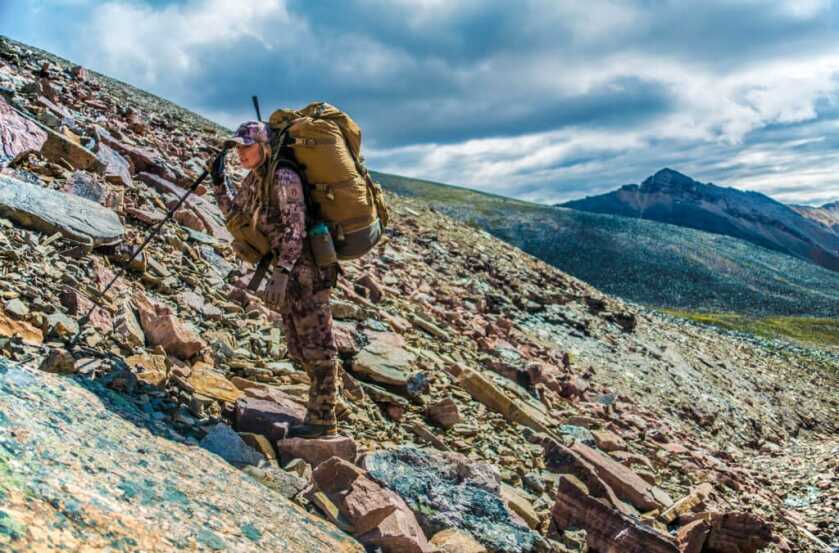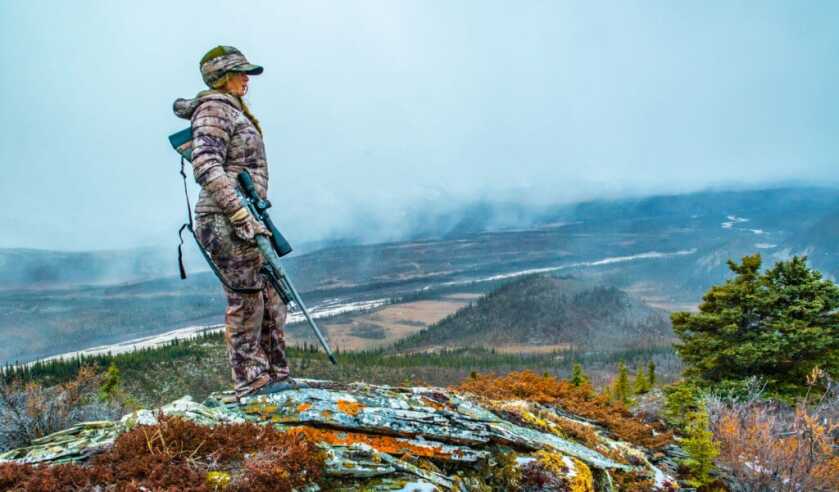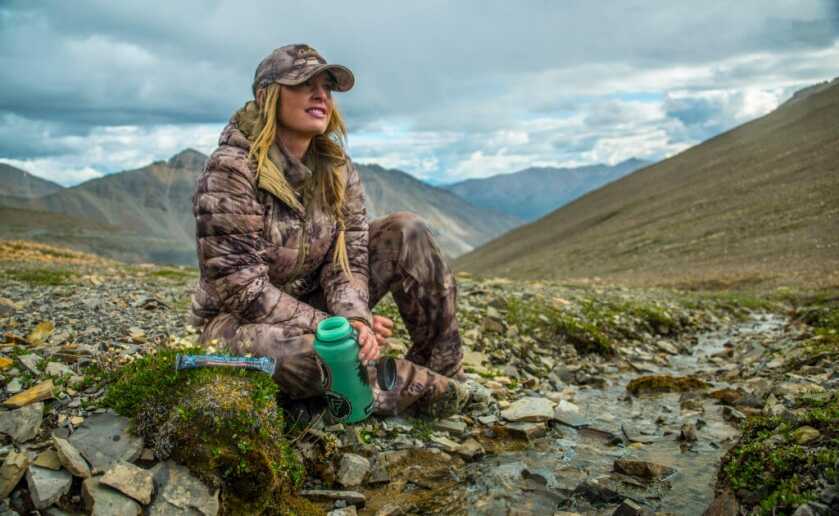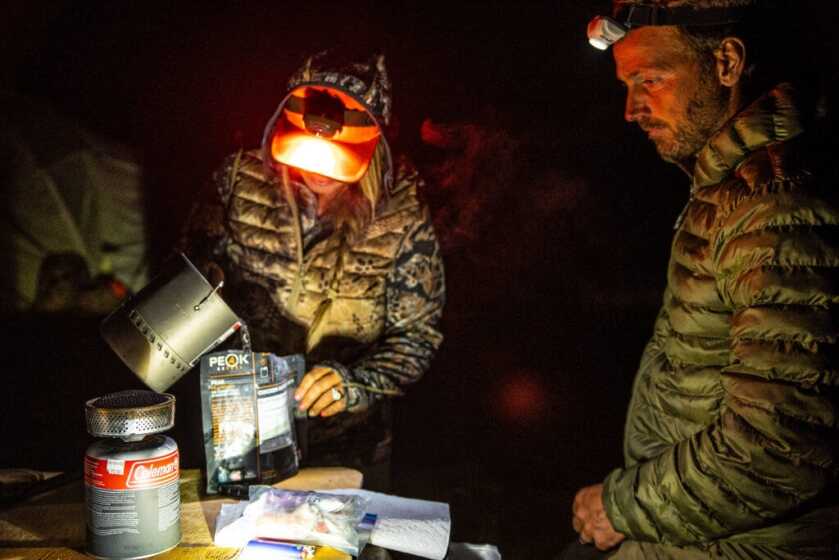
Fall hunting season is here and that means that the first snow has begun to fall across the country, especially in high-elevation mountain regions. The combination of cold weather, altitude, and physical exertion that is found in many fall and winter hunting pursuits brings its own unique set of challenges that require attention to the technical aspects of gear selection. Evaluating your gear before you head afield will help to ensure that you have a more comfortable and, hopefully, successful hunt.
Clothing
Body temperature management when hiking in steep rough terrain while in cold temperatures requires thoughtful planning and a good clothing layering system. Your clothing system should provide warmth, insulation, wind resistance, and waterproofness. Selecting technical clothing will equate to a better experience, even if you find yourself hunting in less-than-ideal conditions.
There is a saying, “Be bold, start cold.” When you begin your hike, if you are comfortably warm, then you are starting out with too many layers of clothing, and you will find that you will quickly work up a sweat. When hiking, strip layers to avoid overheating and sweating, and when it’s time to sit and glass, plan on adding layers of clothing to retain as much body heat as possible.
Socks
Starting with your feet, your socks should keep your feet warm and dry while providing a nice comfortable cushion while hiking. Socks are often sold in varying weights from very light athletic type socks to heavyweight socks. A medium-weight sock will be adequate for moderately cold conditions and are my typical go-to for fall hunts that reach freezing and above. Heavy-weight socks have additional cushion which is nice when carrying a heavy backpack and will also keep your feet warmer in freezing to below-freezing temperatures. Wool and polyester are both good choices, some socks even feature a blend of the two materials.
Sock Hack- Bring a designated pair of heavy-weight, warm sleeping socks that you do not hike in. These keep your feet warm and night and provide a lot of comfort at the end of a long day.
Insulated Booties
There is nothing more miserable than having cold feet and, in many cases, it is the first part of our body to get cold and stay cold all day long. Insulated booties are ultra-light and worth their weight in gold on a cold hunt. Insulated booties are available from a variety of manufacturers and most feature custom sizing and varying levels of fill insulation that can range from 600-800 and are available in down and synthetic construction. Most of the insulated booties are designed to wear on bare feet and can be weatherproofed with a removable overboot.
Base Layers
Overheating in cold weather can cause you to sweat, saturating your clothing. This can become dangerous when you stop moving and the cold air rapidly cools you off. Body temperature regulation starts with your base layers. Base layers need to be breathable and have the technicality to wick moisture away from your skin allowing the garment to dry quickly, keeping you warm and comfortable. The first rule of thumb is that cotton kills. Eliminate all cotton from your hunting wardrobe and instead choose natural or synthetic fabrics that are designed to wick moisture away from your skin and dry quickly.
Merino wool does not collect a sweat smell as heartily as synthetic fabric, however, many synthetic materials are superior in moisture-wicking capabilities which is why many companies are now producing base layers that combine natural materials with synthetic fibers for high-performing base layers. Some base layers feature knit panels that are designed to encourage airflow and breathability, keeping you comfortable.
These technical garments are designed to reduce the smell of body odor, wick moisture away from your skin, drying out rapidly, keeping you warm and comfortable.
Clothing Hack – If you are overnighting or staying out multiple nights, pack along a designated set of sleeping clothes. For me, I typically bring along a lightweight set of long underwear, some heavy-weight warm socks, and an extra beanie. The first thing that I like to do when I get camp set up is put on my sleeping clothes and relax. Trust me, it feels good after a long day.

Mid-Layer Tops
Mid-layer tops serve the purpose of keeping you warm. They are worn over your base layer, by themselves or they can be worn under a heavier jacket. Features like a hood will help retain heat if needed, conversely, the addition of a ¼ zip will help to dump body heat quickly. Fleece and wool make a great mid-layer warming option and when coupled with a down-filled or Primaloft vest, you retain body heat without bulk.
Depending on the outside temperature and how much you have sweated, consider removing your base or mid-layer to set out in the wind to dry. Pack a designated glassing shirt that you do not hike in. This shirt can also double as your designated sleeping shirt. This system will keep your skin dry and the winter chill at bay while glassing. When your hike resumes, the glassing shirt comes off, gets stored in your pack in a waterproof dry bag, and your base and/or normal mid-layer goes back on, even if it is cold and slightly wet. It is nice to have a warm, dry shirt to look forward to putting on at the end of the day.
Drying Hack- To help dry out slightly sweaty items like socks or a sports bra, place them at the foot of your sleeping bag while sleeping and you will be pleasantly surprised in the morning how much your trapped body heat will dry out these items, plus they are more comfortable to put on when they are not ice cold.

Glassing Layer
The glassing layer is exactly what you need when you have worked up a sweat and then sit down to glass. Kifaru’s Lost Park Parka and Pants are water-repellent, extremely warm, and lightweight, serving as an exceptional glassing layer. The pants even feature leg zippers so that you do not have to remove your boots to put them on and take them off.
Kifaru uses Climashield APEX insulation which is treated with a DWR (durable water-repellent) finish that prevents it from absorbing moisture. There is very rare occasion where I have actively hiked in this set due to its extreme warmth, however, I have relied upon it countless times to keep me warm and comfortable while glassing.
Clothing Hack- If you are a cold sleeper, the glassing layer can be worn at night for extra warmth.

Rain Gear
There is no such thing as the perfect set of rain gear for all hunting applications. From ultra-light to insulated, the type of rain gear that you select will depend on the species that you are hunting, anticipated conditions, and terrain. For mountain hunting, you will want breathable and durable rain gear. You will be looking for 100% taped seams, waterproof zippers, and leg or pit zips that help to dump heat when needed. Having the outer layer of the garment treated in a DWR (durable water repellant) means that the water will bead on the surface of the rain gear and quickly shed.
Ultra-light rain gear is nice to carry, often compressing into a fist-size ball featuring extremely thin fabrics and lightweight zippers. If you are not anticipating using your rain gear but mostly having it for a random rain shower, then this is perfect. However, if you are anticipating extended days of bad weather, lightweight rain gear is not necessarily your best choice, especially in brushy conditions that are apt to puncture the garment. I have found that crampons can also quickly destroy the legs of lightweight rain gear, and you will be extremely disappointed if you tear up your only set of rain gear on the first day of a multi-day hunt.
Double-ply rain gear is tough, stormproof, and respectably packable. The breathability of double ply can mean that you may experience additional heat loss when you are sitting and glassing.
Three-ply rain gear will keep you dry, break the wind, and will be durable in the roughest conditions. If I am heading on an extended stay mountain hunt, I pack the few extra ounces and take along three-ply rain gear. It helps keep you warm while sitting and glassing, is the ultimate in storm protection, and is tough enough to withstand being penetrated by brush.

Boot Gators
The addition of gators over your pants will work for you two-fold, they help retain heat while preventing snow from melting into your socks or debris from tumbling into your boots. The bonus is that gators keep your feet dry should you encounter a creek or water crossing.
Neck Gator
The majority of lost body heat is through the head and neck making the neck gator an important layer that you don’t want to leave behind. Neck gators can range from a thin layer to thick fleece that can be pulled up over your nose to keep the cold and wind off of your face.

Gloves
Mountain hunting can be hard on your hands. Wearing a thin hiking glove will protect your hands while keeping them warm. The hiking gloves may get a little sweaty so, in cold conditions, bring along at least one pair of waterproof, insulated gloves that you can slip on while glassing.
Gear

Insulated Seat Pad
Sitting directly on the ground is a sure way to lose a lot of body heat. A closed-cell foam sleeping pad can be cut into small, folding sections that can be used as an insulating seat pad keeping your bottom warm and providing a more comfortable sit while glassing or around camp. One sleeping pad can be cut into several seat mats making it a very affordable, lightweight addition to your next cold-weather hunt.
Battery Life Protection
Cold temperatures can rapidly drain the batteries on devices like your cell phone. To extend the battery life of your electronics, try placing them in your sleeping bag with you at night and during the day, store them in a pocket near your body to help keep them warm.
Another option is to purchase a thermal phone case like the Phoozy thermal phone case that will prevent your phone from overheating in high temperatures and extend your battery life in cold temperatures.
Hand Warmers
The addition of disposable hand warmers makes being outdoors in cold temperatures more comfortable. The type of hand warmer that you may want to select will vary depending on the style of hunting that you will be doing.
Electric hand warmers will require charging which may not be the best choice for extended stay, cold weather, backcountry hunts.
Catalytic hand warmers, like Zippo’s 12-Hour Hand Warmer run-on liquid fuel and are an excellent choice in extremely cold conditions, so long as you don’t forget your lighter. These do have a bit of a user learning curve as to how much fuel you add for the desired amount of burn time, and they can be a bit messy.
Disposable hand warmers are pretty much my go-to for an effective hand warmer and are available in a variety of sizes, and even have chemical warmers designed for your feet. The drawback is that they can be heavy and obviously create additional waste that you need to not only pack in but also out.

Combating Dehydration
The cool, crisp, mountain air that you breathe can be very dry, forcing your body to work harder, and escalating dehydration of the body. Studies have shown that when your body gets cold, your blood supply is moved towards its core, away from your skin causing your brain to not as effectively detect the onset of dehydration. The most common symptoms of cold weather dehydration include dry mouth and headache.
Before you go afield, hydrate up. Consume at least three quarts of water on a typical day and on days where you are taxing your body, with high-intensity treks, double that amount. Adding Wilderness Athlete Hydrate & Recover to your water will keep your body systems properly balanced while the isotonic formulation ensures that needed electrolytes and nutrients are rushed to your muscles and organs where they are needed most combating dehydration and muscle cramps before they begin.
The symptoms of severe dehydration include dizziness, extreme thirst, confusion, rapid breathing, rapid heart rate, and lack of urination. If you or someone that you know finds themselves in a severely dehydrated state, combining Wilderness Athlete Hydrate & Recover with Rescue will boost the quantity of electrolytes, amino acids, and antioxidants delivering fast-acting intense rehydration. Rescue hydration is designed for situations where symptoms of dehydration are already present.
Keeping Your Water Bottle From Freezing
The Nalgene bottle has become my go-to water bottle for the ability to quickly consume water, however, if left overnight in cold conditions, you may awake to a frozen bottle. A hack to keep your water consumable in cold weather is to flip the bottle upside down because water will freeze at the top of a bottle first. Then, when you flip it right side up to drink, you may still have access to unfrozen water leaving the ice at the bottom. Another option is to use a Nalgene insulated sleeve like the Bottle Boot which will prevent water from freezing.

Stove System
A small stove like the MSR Pocket Rocket 2 is an ultra-light way to enjoy a hot drink or meal. When combined with a pot (sold separately) and fuel, this type of stove can weigh around one pound or if there are multiple people in your group, you may prefer the larger MSR Reactor Stove. The addition of a stove to your next cold-weather hunt is a great way to provide a lot of comfort in fueling and warming the body on a cold day.
Packing along powder soup mixes like Lipton chicken and noodle or tomato is both very lightweight and is a great way to warm up your body becoming one of my favorite mid-day glassing treats. A hot cup of herbal tea before bed will warm you up and help with rehydration. Just don’t skip out on using the restroom before climbing into your sleeping bag.
When temperatures are extremely cold and you are awaiting your dehydrated food’s rehydration, it is important to find a way to keep it warm during the process. 40 Below, makes an insulated food bag that will keep your meal warm during hydration and eating. Another option is to place your meal bag inside your jacket which will warm you up as well as insulate your bag during hydration. The downfall of this is that you don’t have the cushiony bag to keep your food warm while eating, so you won’t want to waste any time eating.
Conclusion
Some of the best hunting is done in the cold weather, gear up and get out there. The more comfortable you are while hunting, the more time you will want to spend on the mountain.
***Buy and Sell on GunsAmerica! All Local Sales are FREE!***

